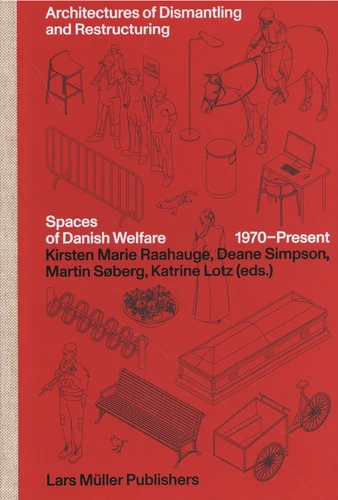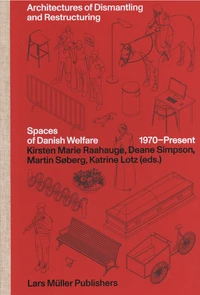- Accueil /
- Martin Soberg
Martin Soberg

Dernière sortie
Architectures of Dismantling and Restructuring
This publication explores a series of urgent questions addressing architecture's role in the welfare and everyday life of citizens, from the interdisciplinary perspectives of architecture, art history and anthropology. With Denmark as a case, it examines how the spatiality of the welfare system has transformed, since the end of the so-called "golden age of the welfare state" in the early 1970s until today.
How have these spatial changes impacted the everyday lives and welfare experiences of citizens ? What happens when institutions are restructured, dismantled or displaced ? How do emerging types of welfare space inform - or become informed by - changed role of the welfare system in our everyday lives ? Rather than unfolding a singular narrative of loss associated with welfare dismantlement - or one of humanization and restructuring of modernist planned environments - it describes complex and shifting spatial materializations of welfare and the "good life" under the influence of a Danish version of the neoliberal turn and other important societal transformations.
How have these spatial changes impacted the everyday lives and welfare experiences of citizens ? What happens when institutions are restructured, dismantled or displaced ? How do emerging types of welfare space inform - or become informed by - changed role of the welfare system in our everyday lives ? Rather than unfolding a singular narrative of loss associated with welfare dismantlement - or one of humanization and restructuring of modernist planned environments - it describes complex and shifting spatial materializations of welfare and the "good life" under the influence of a Danish version of the neoliberal turn and other important societal transformations.
This publication explores a series of urgent questions addressing architecture's role in the welfare and everyday life of citizens, from the interdisciplinary perspectives of architecture, art history and anthropology. With Denmark as a case, it examines how the spatiality of the welfare system has transformed, since the end of the so-called "golden age of the welfare state" in the early 1970s until today.
How have these spatial changes impacted the everyday lives and welfare experiences of citizens ? What happens when institutions are restructured, dismantled or displaced ? How do emerging types of welfare space inform - or become informed by - changed role of the welfare system in our everyday lives ? Rather than unfolding a singular narrative of loss associated with welfare dismantlement - or one of humanization and restructuring of modernist planned environments - it describes complex and shifting spatial materializations of welfare and the "good life" under the influence of a Danish version of the neoliberal turn and other important societal transformations.
How have these spatial changes impacted the everyday lives and welfare experiences of citizens ? What happens when institutions are restructured, dismantled or displaced ? How do emerging types of welfare space inform - or become informed by - changed role of the welfare system in our everyday lives ? Rather than unfolding a singular narrative of loss associated with welfare dismantlement - or one of humanization and restructuring of modernist planned environments - it describes complex and shifting spatial materializations of welfare and the "good life" under the influence of a Danish version of the neoliberal turn and other important societal transformations.
